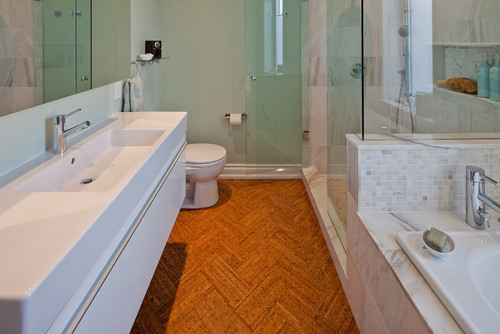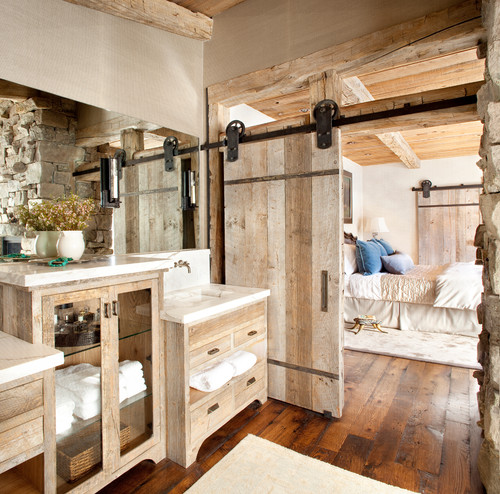-Vinyl is made of PVC and off-gasses in your home. What you are breathing in can hurt your lungs, contribute to asthma and potentially lead to even more serious health conditions over a long exposure time.*
-All of that PVC creates a huge environmental impact, from manufacturing right through to disposal, since it is not recylcable and does not break down.
-It won't last as long as other more durable options, meaning over the long run it will cost you as much as other materials anyway.
* Let me state that the vinyl industry is working on improvements to the material that will lessen both the health and environmental impacts, so hopefully good things are on their way. By doing some research I did find that Armstrong has come out with a vinyl flooring product that emits lower VOCs, so that is a step in the right direction.
So what are the most inexpensive and easy alternatives to vinyl flooring?
1. Cork. It comes from a rapidly renewable source, is sustainable and comfortable underfoot, and can easily be installed as a click-together floating floor or as glued-down tiles. It is naturally insulating, so would be warm on the tootsies, and it is impermeable to liquid. Perfect for the bathroom. I wrote more about using cork here. Stylish options like wood and marble looks can be found at hardware and flooring stores, and also online. Cost: $3-12 per sqft.
2. Linoleum. Yep, this is the stuff that is under three other layers of flooring in houses dating back into the 19th and early half of the 20th centuries. It's making a comeback. Made from linseed oil, powdered cork, powdered wood, limestone, jute and pine, lineoleum is catching on as a sustainable flooring option. The raw materials are rapidly renewable, and it is recyclable - even biodegradable, given enough time. Though a bit more expensive than vinyl, it also comes in sheets and will hold up to heavy traffic, lasting for many years. Can be more tricky to install though, and you may want to use a professional. Marmoleum is one of the most readily available brands, and has a great overview here. Cost: $3-7 per sqft.
 |
| via |
3. Reclaimed hardwood. A popular style right now, using reclaimed planks for a bath is an option that saves on buying 'new' material, and will last forever. Water resistant and comfy, reclaimed wood can simply be covered with a water based sealer to let the natural beauty shine through, or painted to create a country cottage look. Easy to find and install. Cost: $0-5 per sqft, depending on availability in your area.
4. Recycled-content tile. Ceramic and glass tile that has a high recycled material content is becoming more available and in more style options. Durable and with a long life-cycle, recycled-content tile can be a sustainable option. As long as you can rent a tile cutter, it's pretty easy to install. Can be cold on the feet though. Cost: $5-15 per sqft.
Choosing sustainable flooring for better indoor air quality and to lessen environmental impact will be healthy for both your family and the planet. With such stylish and cost-effective options available, how can you not?
Choosing sustainable flooring for better indoor air quality and to lessen environmental impact will be healthy for both your family and the planet. With such stylish and cost-effective options available, how can you not?







Great article. This project has used BRABBU pieces? :) Thank you.
ReplyDeleteThanks for reading and glad you found the article useful. I'm not sure what was used in the projects - just follow the links under the pictures to the sources and designers, who may be able to give you more information.
Delete